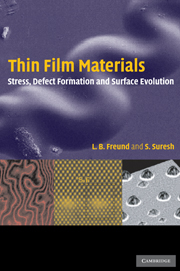Book contents
- Frontmatter
- Contents
- Preface
- 1 Introduction and Overview
- 2 Film stress and substrate curvature
- 3 Stress in anisotropic and patterned films
- 4 Delamination and fracture
- 5 Film buckling, bulging and peeling
- 6 Dislocation formation in epitaxial systems
- 7 Dislocation interactions and strain relaxation
- 8 Equilibrium and stability of surfaces
- 9 The role of stress in mass transport
- References
- Author index
- Subject index
3 - Stress in anisotropic and patterned films
Published online by Cambridge University Press: 06 July 2010
- Frontmatter
- Contents
- Preface
- 1 Introduction and Overview
- 2 Film stress and substrate curvature
- 3 Stress in anisotropic and patterned films
- 4 Delamination and fracture
- 5 Film buckling, bulging and peeling
- 6 Dislocation formation in epitaxial systems
- 7 Dislocation interactions and strain relaxation
- 8 Equilibrium and stability of surfaces
- 9 The role of stress in mass transport
- References
- Author index
- Subject index
Summary
In the previous chapter, fundamental issues that arise when considering stress and deformation in film–substrate systems were examined, with attention restricted to systems for which the materials are isotropic and the film geometry is continuous. Some film materials exhibit anisotropy in their elastic properties. In other cases, an isotropic film may be patterned on a small scale in such a way that it gives rise to an apparent anisotropy on a larger scale. These effects can have a significant influence on mechanical response. Geometric inhomogeneity can arise as a result of film patterning, composite films, island formation, distributed film cracks or other circumstances. This chapter deals with the role of material anisotropy and geometric nonuniformity in influencing stress and deformation in layered solids.
The chapter begins with an overview of elastic anisotropy in crystalline materials. Anisotropy of elastic properties in materials with cubic symmetry, as well as other classes of material symmetry, is described first. Also included here are tabulated values of typical elastic properties for a variety of useful crystals. Examples of stress measurements in anisotropic thin films of different crystallographic orientation and texture by recourse to x-ray diffraction measurements are then considered. Next, the evolution of internal stress as a consequence of epitaxial mismatch in thin films and periodic multilayers is discussed. Attention is then directed to deformation of anisotropic film–substrate systems where connections among film stress, mismatch strain and substrate curvature are presented.
- Type
- Chapter
- Information
- Thin Film MaterialsStress, Defect Formation and Surface Evolution, pp. 154 - 219Publisher: Cambridge University PressPrint publication year: 2004



